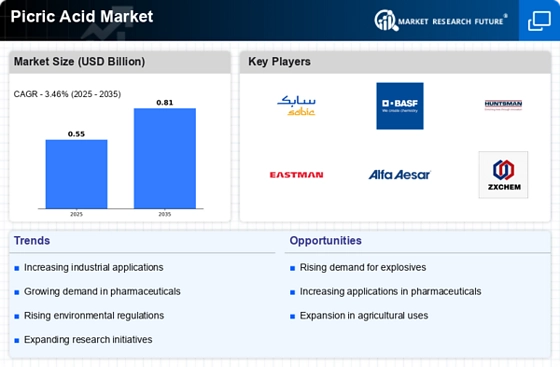Rising Demand in Pharmaceuticals
The Picric Acid Market is experiencing a notable increase in demand from the pharmaceutical sector. Picric acid is utilized in the synthesis of various pharmaceutical compounds, including antiseptics and anti-inflammatory agents. As the healthcare sector continues to expand, the need for effective medicinal products is likely to drive the demand for picric acid. Recent data indicates that the pharmaceutical industry is projected to grow at a compound annual growth rate of approximately 5.5 percent over the next few years. This growth may lead to an increased requirement for picric acid, thereby positively impacting the Picric Acid Market.
Growth in Explosives Manufacturing
The Picric Acid Market is significantly influenced by the growth in explosives manufacturing. Picric acid is a key component in the production of military and industrial explosives. With ongoing investments in defense and construction sectors, the demand for explosives is expected to rise. Reports suggest that the explosives market is anticipated to grow at a rate of around 4 percent annually. This trend may result in heightened consumption of picric acid, thereby bolstering the Picric Acid Market. The interplay between defense spending and industrial applications could further enhance market dynamics.
Technological Advancements in Production
Technological advancements in the production processes of picric acid are likely to serve as a catalyst for the Picric Acid Market. Innovations in manufacturing techniques can lead to more efficient and cost-effective production methods. Enhanced production capabilities may not only reduce costs but also improve the quality of picric acid. As manufacturers adopt these advanced technologies, the overall supply chain efficiency is expected to improve, potentially leading to a more competitive market landscape. This evolution in production technology could significantly influence the growth trajectory of the Picric Acid Market.
Regulatory Compliance and Safety Standards
The Picric Acid Market is also shaped by the evolving regulatory landscape concerning safety and environmental standards. Governments and regulatory bodies are implementing stricter guidelines for the handling and usage of hazardous materials, including picric acid. Compliance with these regulations is essential for manufacturers to operate effectively. As companies invest in safety measures and sustainable practices, the overall market dynamics may shift. This regulatory influence could lead to increased operational costs but may also enhance the reputation and marketability of products within the Picric Acid Market.
Increasing Research and Development Activities
The Picric Acid Market is benefiting from increasing research and development activities across various sectors. Academic institutions and private companies are investing in R&D to explore new applications of picric acid, particularly in materials science and nanotechnology. This focus on innovation may lead to the discovery of novel uses for picric acid, thereby expanding its market potential. As research initiatives gain momentum, the Picric Acid Market could witness a surge in demand driven by new applications and enhanced product offerings.

















Leave a Comment